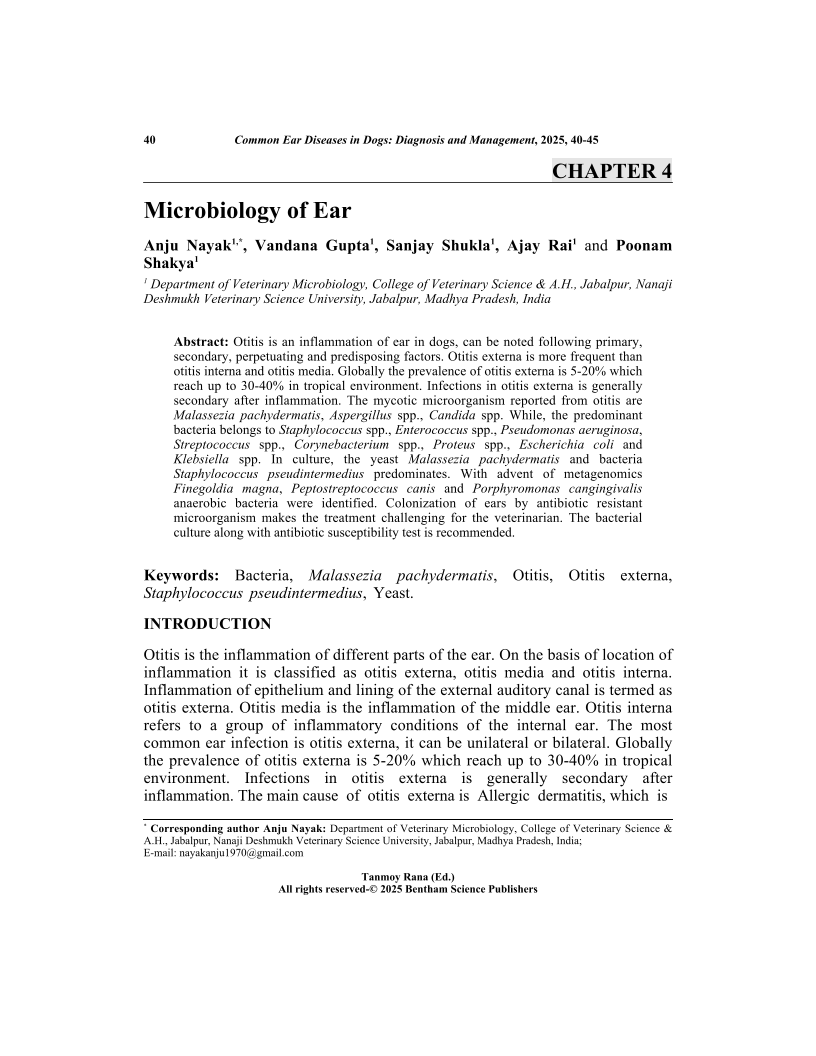Microbiology of Ear

- Authors: Anju Nayak1, Vandana Gupta2, Sanjay Shukla3, Ajay Rai4, Poonam Shakya5
-
View Affiliations Hide Affiliations1 Department of Veterinary Microbiology, College of Veterinary Science & A.H., Jabalpur, Nanaji Deshmukh Veterinary Science University, Jabalpur, Madhya Pradesh, India 2 Department of Veterinary Microbiology, College of Veterinary Science & A.H., Jabalpur, Nanaji Deshmukh Veterinary Science University, Jabalpur, Madhya Pradesh, India 3 Department of Veterinary Microbiology, College of Veterinary Science & A.H., Jabalpur, Nanaji Deshmukh Veterinary Science University, Jabalpur, Madhya Pradesh, India 4 Department of Veterinary Microbiology, College of Veterinary Science & A.H., Jabalpur, Nanaji Deshmukh Veterinary Science University, Jabalpur, Madhya Pradesh, India 5 Department of Veterinary Microbiology, College of Veterinary Science & A.H., Jabalpur, Nanaji Deshmukh Veterinary Science University, Jabalpur, Madhya Pradesh, India
- Source: Common Ear Diseases in Dogs: Diagnosis and Management , pp 40-45
- Publication Date: January 2025
- Language: English
Microbiology of Ear, Page 1 of 1
< Previous page | Next page > /docserver/preview/fulltext/9789815313598/chapter-4-1.gif
Otitis is an inflammation of ear in dogs, can be noted following primary, secondary, perpetuating and predisposing factors. Otitis externa is more frequent than otitis interna and otitis media. Globally the prevalence of otitis externa is 5-20% which reach up to 30-40% in tropical environment. Infections in otitis externa is generally secondary after inflammation. The mycotic microorganism reported from otitis are Malassezia pachydermatis, Aspergillus spp., Candida spp. While, the predominant bacteria belongs to Staphylococcus spp., Enterococcus spp., Pseudomonas aeruginosa, Streptococcus spp., Corynebacterium spp., Proteus spp., Escherichia coli and Klebsiella spp. In culture, the yeast Malassezia pachydermatis and bacteria Staphylococcus pseudintermedius predominates. With advent of metagenomics Finegoldia magna, Peptostreptococcus canis and Porphyromonas cangingivalis anaerobic bacteria were identified. Colonization of ears by antibiotic resistant microorganism makes the treatment challenging for the veterinarian. The bacterial culture along with antibiotic susceptibility test is recommended.
-
From This Site
/content/books/9789815313598.chapter-4dcterms_subject,pub_keyword-contentType:Journal -contentType:Figure -contentType:Table -contentType:SupplementaryData105

